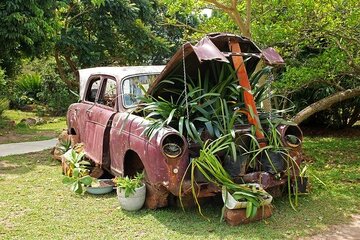 For container gardening ideas, search the internet, the library or a bookstore. The challenge is to come up with a pleasing container garden design. There are an unlimited variety of containers available for your container garden. These range in size from small house-plant pots to large boxes and planters. Equally variable are the materials from which they are made. These include wood, glass, clay, aluminum, bamboo, straw, plastic, fiberglass, terra cotta, tin, cast iron, zinc, copper, and brass, each with certain advantages and disadvantages. What you select will depend on availability, cost, background, and appeal, not to mention the characteristics of the gardening pots.  Here are some container gardening ideas. In addition to traditional circular pots and tubs, there are modern and ultra-modern formsósquare, rectangular, triangular, hexagonal, and octagonal. Also eligible are old iron kitchen pots, kettles, pails, jugs, casks, vases, crocks, jelly tubs, barrels and nail kegs, Japanese fish tubs, old sinks, bathtubs, bamboo soy tubs. There are novelty containers such as driftwood, wheelbarrows, donkey carts, spinning wheels and boxes attached to roadside mail receptacles. There are also bird cages, decorative well heads, animal figures, and Strawberry jars. Woven baskets may be used to conceal unattractive containers. Even tar paper pots, handled by garden centers and florists, are worthwhile if painted or covered to improve their appearance. Any of these can be used in your container gardening ideas.  Where to find your container supplies? Start with what you have. If you scout cellars or basements, attics, garages, and sheds, you will doubtless encounter something interesting. Old-fashioned pots and kettles, often sold in antique shops at country auctions or seen at old New England inns, have much appeal. Other container garden ideas are to consider old cookie and bean jars, pickle and other types of crocks, wash tubs, coal pails, jardiniéres, and ceramic bowls. For drainage, spread a thick layer of large pebbles or broken pieces of pots or bricks at the bottom and then water plants with care. In large containers of this kind, drainage material should be several inches thick. Where rainfall is heavy, be sure to keep garden containers without drainage outlets on porches, under awnings or the broad eaves of houses. With pails and old galvanized wash tubs, holes can be easily punctured at the bottom. Plants in containers without drainage openings remain moist longer. Some of these crocks, jardiniéres and cookie jars are heavy enough to be secure against wind in outside container gardening.  What constitutes the ideal container for your container garden ideas? A container must be attractive, even if it is not an object of art. It should be strong and durable and able to resist all kinds of weather. This is especially true of large sizes, which usually remain outdoors all year round. In the North, alternate freezing and thawing is a problem in winter (and could cause cracking); in tropical climates, excessive heat, humidity, and moisture are to be considered (and could cause fading). And in semiarid areas, there is the effect of scorching sun to keep in mind, another cause of fading. All these things must be kept in mind when coming up with your container gardening design.  The ideal container must be large enough to hold a substantial amount of soil. It should have good drainage facilities through holes or other openings at the bottom or sides, though this is not absolutely necessary. It must not rust, at least in a single season, and it should have a wide enough base to rest firmly wherever placed. Besides, it ought to be heavy enough to withstand average winds. In severe storms like hurricanes and tornadoes, movable containers can be shifted to temporary safety. All of these things should be factored in when you are coming up with your container gardening ideas.  Resistance to rot is another requirement. Wooden containers - except those made of rot-resistant redwood, Western cedar, and Southern red cypress - will need to be treated with a wood preservative. Except for permanent containers, the ability to move your container garden is another feature, and sometimes a safety precaution, of portable container gardening. Large boxes and planters can be fitted with wheels, and garden centers have redwood tubs that rest on platforms with wheels. A hole in the platform corresponds to the hole in the tub. Large containers without wheels can be pushed on iron or wooden rollers by two or more persons; however, if you live in an area prone to disastrous storms it is best to keep your containers small. Smaller containers are ideal for growing herb container gardens. If you plan to plant an herb container garden be imaginative Here are some container garden ideas for herbs that will go well together.
So these are just a few container gardening ideas. Get out a pad of paper and make up a container garden design that will please the eye and maybe even the palate
Happy Container Gardening! The Bristol Gardening Team is always available to provide you with support in making the best out of your happy place. Call us now for a free quote.
3 Comments
Home and Garden Digest
19/4/2023 19:47:20
This is a PLR article
Reply
3/5/2023 05:39:43
That really helps especially if you only have a small space for gardening!
Reply
Leave a Reply. |
BlogTips & Tricks from our experts to keep your garden in great shape! Archives
May 2022
Categories
All
|
Bristol Gardening
0117 325 5970
0117 325 5970
In association with:



 RSS Feed
RSS Feed

